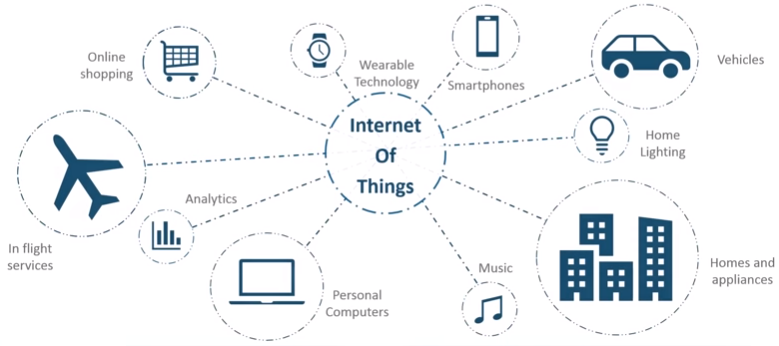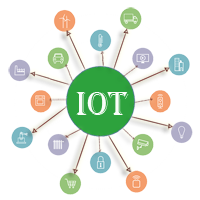INTERNET OF THINGS (IOT)
OVERVIEW
The Internet of Things (IoT) represents a groundbreaking technological concept where physical devices, such as appliances, vehicles, and other objects, are embedded with sensors, software, and connectivity, enabling them to collect and exchange data over the internet. This interconnected ecosystem allows devices to operate autonomously, providing greater efficiency, convenience, and automation in daily life and industries alike.
At its core, IoT involves the seamless integration of devices into a unified network, where they can communicate and interact with one another or with external environments. These devices, equipped with unique identifiers, are capable of transferring data without requiring human-to-human or human-to-computer interaction. The term "things" in IoT broadly encompasses everything from smart home appliances and wearable devices to vehicles and industrial machinery, all interconnected through the internet.
For example, consider a smartphone with features like GPS tracking, adaptive brightness, and voice detection. While these functions independently enhance user experience, their integration through IoT can create a more intelligent environment. Imagine your phone adjusting its brightness based on your location or direction using GPS data—this is the potential of IoT in action.
IoT's applications extend far beyond smart devices. It is a cornerstone of advancements in fields such as healthcare, agriculture, energy, and urban development. In smart homes, IoT enables the connection of appliances to a central platform, allowing users to control lighting, air conditioning, and even track car locations or fuel levels remotely. For instance, your air conditioner can automatically set the preferred room temperature before you arrive home by analyzing your car's GPS location.
This convergence of artificial intelligence, cloud computing, sensors, and networking enables IoT systems to deliver unparalleled transparency, control, and performance. By leveraging real-world data through embedded systems and data analytics, IoT devices can make intelligent decisions and take actions that enhance efficiency and user experience.
In essence, the Internet of Things transforms how we interact with technology by creating intelligent, interconnected systems that simplify and enrich our lives. The promise of IoT lies in its ability to revolutionize industries and redefine convenience, paving the way for a more connected and automated future.

Some Other Definations o IoT
IoT is the concept of connecting everyday devices, such as appliances, vehicles, and wearable technology, to the internet to enable communication and automation.
IoT refers to the interconnected network of devices that businesses use to collect and analyze data, improve operational efficiency, optimize decision-making, and enhance customer experiences.
IoT is the integration of physical devices with digital systems to create a connected ecosystem that automates tasks, gathers real-time data, and provides actionable insights for various applications.
IoT enables smart living by connecting devices like thermostats, lights, and security cameras to the internet, allowing users to control them remotely and automate daily routines.
IoT is an ecosystem where devices equipped with sensors and connectivity communicate with each other and cloud platforms, enabling intelligent interactions and processes.
IoT is an innovative network of devices that use embedded systems to sense, process, and transmit data, offering transformative solutions in fields like healthcare, agriculture, and urban planning.
IoT is a network of "things" — devices, machines, or objects — that are equipped with technology to connect, interact, and share data over the internet.
IoT is a framework of advanced automation and analytics that integrates artificial intelligence, sensors, and cloud computing to deliver enhanced services and solutions.
The Internet of Things is a global infrastructure for the information society, enabling advanced services by interconnecting physical and virtual things based on existing and evolving communication technologies.

History of IoT
1982: The first IoT example emerged with a vending machine at Carnegie Mellon University, reporting inventory and status online.
1990: A toaster connected to the internet introduced the concept of remote control for household appliances.
1999: Kevin Ashton coined the term "Internet of Things," laying the foundation for interconnected devices.
2000: The LG Smart Fridge allowed users to manage refrigerator contents remotely.
2004: Smartwatches brought IoT into wearable tech, providing fitness tracking and notifications.
2007: The iPhone integrated IoT with apps, making smartphones hubs for services and devices.
2009: IoT entered the automotive sector, enabling real-time diagnostics and performance monitoring.
2011: Smart TVs integrated internet connectivity for streaming and apps, bringing IoT to entertainment.
2013: Google Lens showcased IoT’s potential in image recognition, linking physical objects to digital information.
2014: Amazon's Echo, with Alexa, demonstrated voice-activated IoT, revolutionizing smart homes.
2015: Tesla’s Autopilot system introduced semi-autonomous driving, illustrating IoT in automobiles.
Why IoT Matters
IoT matters because it enables devices to send and receive information, making them "smart." These devices can be categorized into three types:
- Collecting and Sending Information:Sensors, such as temperature or moisture sensors, gather data from the environment. For example, a farm sensor that monitors soil moisture can help farmers water crops efficiently, saving costs and improving yields.
- Receiving and Acting on Information:Devices can receive commands and act upon them. For example, your printer receives a document and prints it, or your car unlocks when it receives a signal from your keys.
- Doing Both: The most powerful IoT devices collect data, act on it, and make decisions automatically. For instance, an irrigation system that monitors soil moisture can water crops as needed, adjusting based on weather forecasts.
IoT’s ability to collect, send, and act on information allows for intelligent, automated systems that improve efficiency and decision-making across various industries, such as agriculture, healthcare, and transportation.
Vison of IoT
Connecting Everything
Build a world where all devices, gadgets, and objects are connected to each other and work together.Smart Automation
Make devices smart enough to do tasks automatically, saving time and effort for people.Better Everyday Life
Use IoT to improve how we live, whether at home, in cities, in schools, or at work.Save Resources
Help save energy, water, and other resources by using technology efficiently.Smarter Industries
Transform factories, farms, and businesses to work faster and better with the help of IoT.Adapt to Changes
Create systems that can adjust and keep working well, even when things change or problems arise.Work Together Globally
Encourage countries, companies, and people to work together to create universal rules and technology for IoT.Safe and Fair Use
Protect everyone’s data and privacy while making sure IoT is used responsibly and ethically.
Key Concepts of IoT
- Connectivity:Devices connect to the internet through networks like LPWAN (Sigfox, LoRaWAN, NB-IoT).
- Sensing:Devices use sensors to collect data about the environment.
- Communication:Devices communicate with each other and the cloud using protocols like MQTT and HTTP.
- Analytics: Data is analyzed to optimize processes and improve decision-making.
Technology Behind IoT
- Sensors:Measure physical conditions and send data.
- Communication Protocols:Enable devices to communicate (e.g., MQTT, HTTP).
- Networking Technologies: Connect devices to the internet (e.g., Wi-Fi, cellular).
- Cloud Computing:Stores and processes IoT data.
- Data Analytics:Extracts insights from IoT data.
Key Features of IoT
- Connectivity: IoT devices are connected to each other and to cloud platforms, allowing for communication and data sharing.
- Sensing: Sensors in IoT devices collect data from the environment, such as temperature, motion, or humidity.
- Data Processing: Data collected by IoT devices is processed either locally or in the cloud to gain valuable insights.
- Automation: IoT devices can automatically trigger actions based on sensor data, such as turning on lights or adjusting a thermostat.
- Integration: IoT devices can be integrated into existing systems or other devices, improving functionality and user experience.
- Real-Time Analytics: IoT systems analyze data in real-time to provide immediate feedback or decision-making.
- Remote Control: Users can control IoT devices remotely through apps or other interfaces.
- Security: Security features ensure that IoT devices and data are protected from unauthorized access or attacks.
- Scalability: IoT systems can scale to accommodate more devices or data as needed.
- Artificial Intelligence: IoT uses AI to improve efficiency and decision-making by learning from data and predicting outcomes.
IoT Applications
- Smart Homes: Devices like thermostats and locks improve comfort and security.
- Smart Cities:Optimize infrastructure, traffic, and public services.
- Industrial IoT: Improve productivity by monitoring machinery and processes.
- Healthcare:Wearables track health and provide real-time feedback.
- Logistics:Track goods and optimize supply chains.
- Agriculture:Improve crop yields and manage resources efficiently.
- Environment:Monitor pollution and protect wildlife
Modern Applications of IoT
- Smart Grids and energy saving
- Smart cities
- Smart homes/Home automation
- Healthcare
- Earthquake detection
- Radiation detection/hazardous gas detection
- Smartphone detection
- Water flow monitoring
- Traffic monitoring
- Wearables
- Smart door lock protection system
- Robots and Drones
- Healthcare and Hospitals, Telemedicine applications
- Security
- Biochip Transponders (For animals in farms)
- Heart monitoring implants (Example Pacemaker, ECG real time tracking)
- Agriculture
- Industry
Advantages of IoT
- Improved efficiency and automation of tasks.
- Increased convenience and accessibility of information.
- Better monitoring and control of devices and systems.
- Greater ability to gather and analyze data.
- Improved decision-making.
- Cost savings.
Disadvantages of IoT
- Security concerns and potential for hacking or data breaches.
- Privacy issues related to the collection and use of personal data.
- Dependence on technology and potential for system failures.
- Limited standardization and interoperability among devices.
- Complexity and increased maintenance requirements.
- High initial investment costs.
- Limited battery life on some devices.
- Concerns about job displacement due to automation.
- Limited regulation and legal framework for IoT, which can lead to confusion and uncertainty.